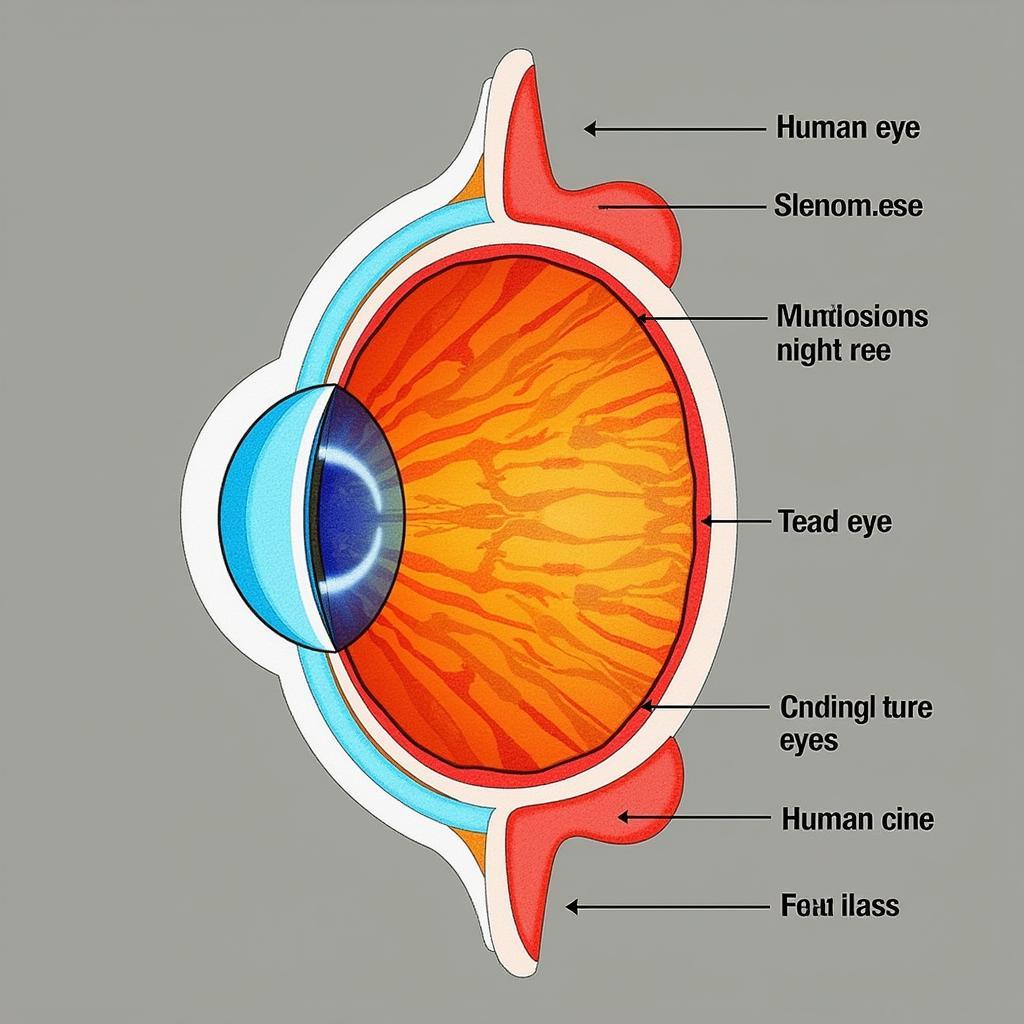Do chickens see in color? The answer is a resounding yes! In fact, chickens have even better color vision than humans. Their complex visual system allows them to perceive a wider spectrum of colors, impacting their behavior, feeding habits, and overall well-being. This article will delve into the fascinating world of chicken vision, exploring how they see color and how it influences their daily lives.
Chickens, like many other birds, possess tetrachromatic vision, meaning they have four types of color receptors called cones in their eyes. do chickens see color Humans, on the other hand, have trichromatic vision with only three types of cones, limiting our color perception. This extra cone in chickens allows them to see ultraviolet light, a color invisible to the human eye.
The Colorful World of a Chicken
So, what does this mean for a chicken’s everyday experience? Imagine a world bursting with even more vibrant hues than we can perceive. Flowers, foliage, and even other chickens appear more distinct and colorful to them. This superior color vision plays a crucial role in various aspects of their lives.
Foraging and Feeding
Color helps chickens distinguish between ripe and unripe food. They can readily identify brightly colored insects, berries, and seeds against a backdrop of green leaves. This ability to discern subtle color variations is essential for their survival in the wild and contributes to their efficient foraging in domestic settings. They can even differentiate between different types of feed based on color, showing preferences for certain hues.
Social Interactions
Color also plays a role in chicken social dynamics. The vibrant colors of a rooster’s comb and wattles, for instance, are crucial for attracting mates and establishing dominance within the flock. what color is a rooster Hens, too, can assess the health and vitality of potential mates based on the vibrancy of their plumage.
 Chicken Foraging Using Color Vision
Chicken Foraging Using Color Vision
Environmental Awareness
The ability to see ultraviolet light further enhances a chicken’s perception of its environment. UV light can reflect off surfaces differently than visible light, allowing chickens to detect patterns and contrasts that we cannot see. This might help them navigate, identify predators, or even locate suitable nesting sites.
How Does Chicken Color Vision Compare to Humans?
Humans can see colors ranging from violet to red, encompassing the wavelengths of the rainbow. Chickens, with their tetrachromatic vision, see this range and beyond, extending into the ultraviolet spectrum. This gives them a distinct advantage in perceiving color nuances and subtle variations. They can see colors that we can only imagine.
 Chicken Eye Structure and Color Receptors
Chicken Eye Structure and Color Receptors
Do different chicken breeds see color differently?
While all chickens possess tetrachromatic vision, there might be subtle variations in color perception between different breeds. Factors such as the density of cones and the specific types of cones present could influence how individual chickens experience color. what color eggs do orpingtons lay However, more research is needed to fully understand these potential differences.
Expert Insights on Chicken Color Vision
Dr. Ava Chen, a leading avian veterinarian, emphasizes the importance of color in a chicken’s world: “Color is not just an aesthetic element for chickens; it’s a vital tool for survival and social interaction. Their enhanced color vision allows them to navigate their environment, find food, and communicate effectively with other members of their flock.”
Professor David Miller, a poultry scientist, adds, “Understanding chicken color vision is crucial for optimizing their welfare in both commercial and backyard settings. Providing a stimulating environment with diverse colors can enrich their lives and promote natural behaviors.”
what color eggs do cochins lay Understanding how chickens see color can help us better appreciate their complex and fascinating world.
Conclusion
Do chickens see color? Absolutely! Their tetrachromatic vision gives them a vibrant and nuanced perception of the world, impacting their behavior, feeding habits, and overall well-being. From foraging for food to choosing a mate, color plays a crucial role in the lives of these feathered creatures. By understanding their visual capabilities, we can better appreciate the richness of their sensory experience and ensure their optimal care. what color are rhode island red eggs
FAQ
- Can chickens see in the dark? No, chickens have limited night vision.
- What colors are most stimulating for chickens? Bright colors like red, orange, and yellow.
- Do chickens prefer certain colors of food? Studies suggest some chickens show preferences for specific colors.
- Can color affect egg production? While not directly linked, a stimulating environment can positively impact overall health and potentially egg production.
- How does ultraviolet light affect chickens? UV light enhances their ability to see contrasts and patterns.
- Why is it important to understand chicken color vision? It helps us optimize their environment and welfare.
- Are there any differences in color vision between male and female chickens? Research is still ongoing to fully understand potential differences.
Need help with your chicken coop color scheme or have other poultry-related questions? Contact us! Phone: 0373298888, Email: SEO.backlink@gmail.com. Visit us at 86 Cầu Giấy, Hà Nội. We have a 24/7 customer service team.
